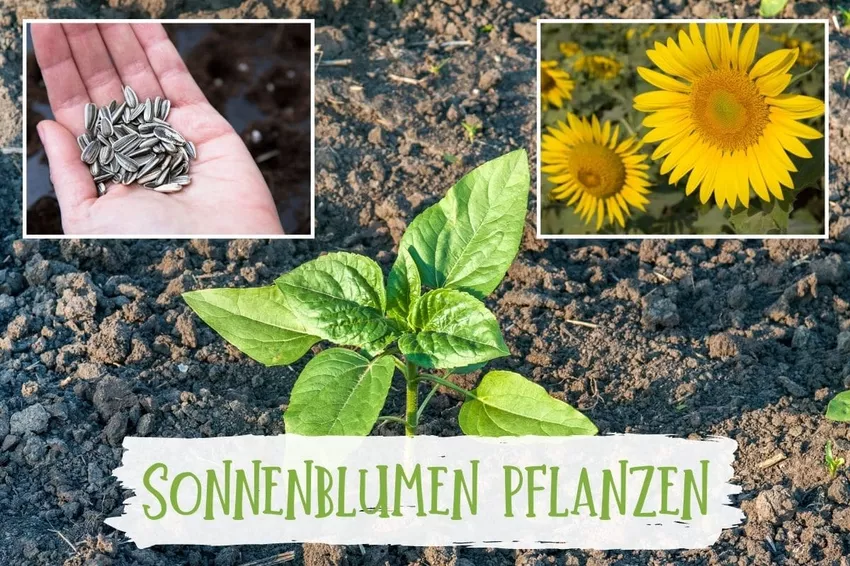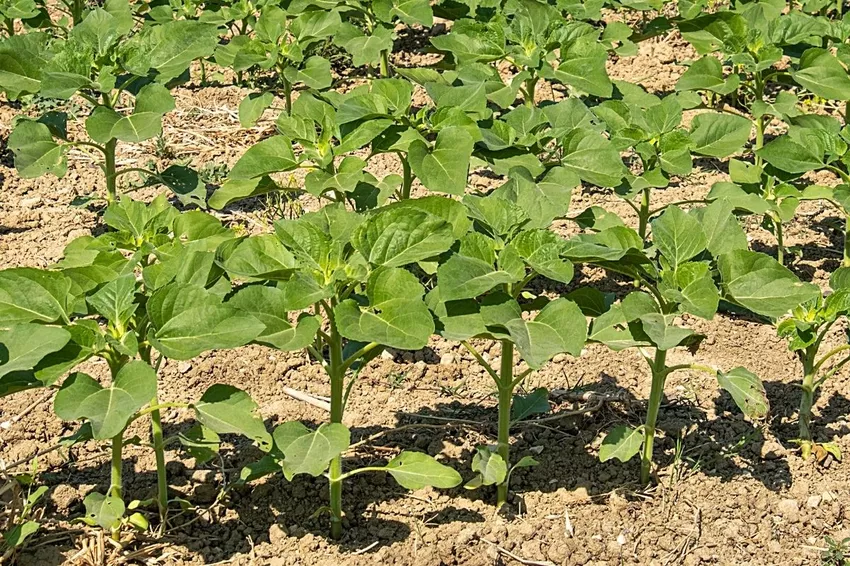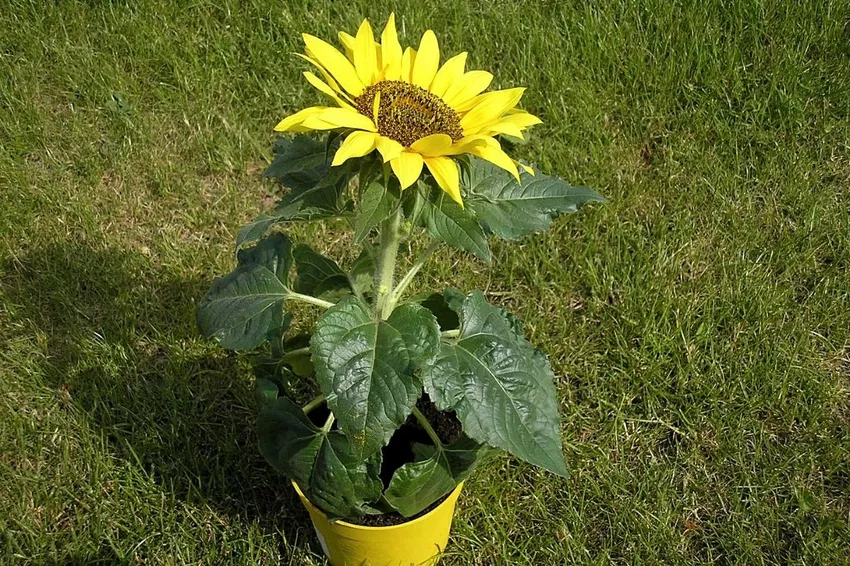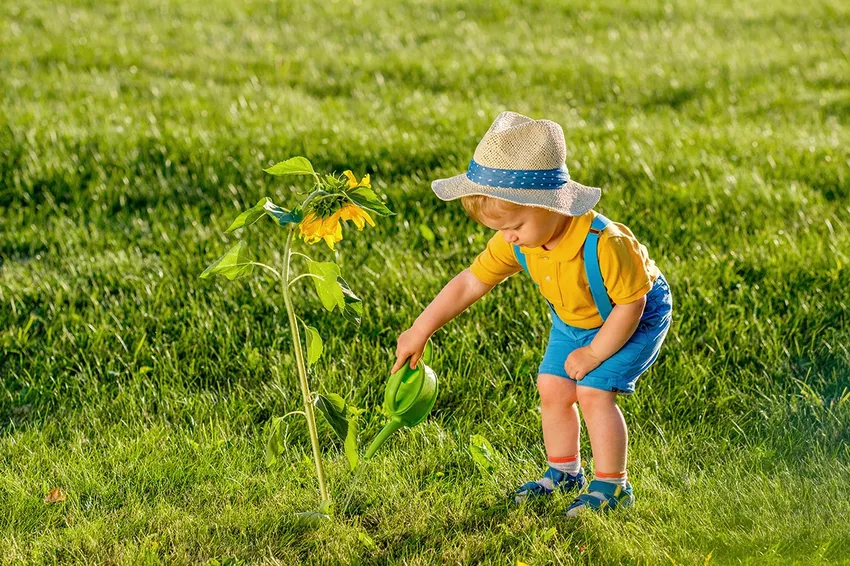- Re-sow annually
- Instructions for direct sowing
- Cultivate in pots
- The right location
- proper care
- frequently asked Questions

Sunflowers (Helianthus) set wonderful accents in every garden with their distinctive flower heads. When growing and planting, however, there are a few things to consider so that they can compete with the sun.
In a nutshell
- annual and perennial varieties
- Sow annual varieties every year
- Pre-cultivation in the house or direct sowing outdoors possible
- Only plant young plants outside after the ice saints
- need a lot of water and nutrients
Re-sow annually
Annual sunflowers can grow to between two and three meters tall with proper planting and care. The flower heads appear from July to October and can reach a diameter of up to 30 cm or more, depending on the variety. The color palette ranges from golden yellow to brown to flamed red. The big giants look robust, but they are quite sensitive and not hardy. They therefore have to be sown again and again every year and then need good care. Sunflowers take eight to 14 weeks to grow. Sowing can be done directly in the field, but pre-cultivation is also possible. These sunflowers usually flower earlier than those sown outdoors.

Prefer indoors
You can plant and grow sunflowers indoors as early as March to early April. This can be done in seed trays or small pots. The preculture in small pots has the advantage that the young seedlings do not have to be pricked out. The pots should have a diameter of 10 to 12 cm. Normal garden soil, which has been enriched with mature compost, or normal potting soil can be used as a substrate. It is then sown as follows
- Fill pots or seed trays with substrate
- Use 2 to 3 seeds per pot
- stick it 2 cm deep in moist soil
- Sunflowers are dark germinators
- Cover seeds with soil
- Keep pots warm and bright
- Germination takes place at 15 to 20 °C
- Germination time 8 to 14 days
- not all seeds germinate at the same time
- Keep soil well moist
- but avoid waterlogging
- Otherwise the seeds will rot

When the seedlings have two to three leaves, the two weakest seedlings are pulled out or pinched off. Only the strongest plant stays in the pot. This is then cultivated in the house until it is finally planted outdoors. Are important
- a bright, warm, sunny spot
- constant temperatures around 15 °C
- adequate and regular watering
- no waterlogging
The young plants have a very high water requirement. Normally, the young plants do not necessarily have to be repotted if they are grown in a pot. Unless the pot has become too small and the roots are already sticking out of the water drainage holes. Here it is advisable to move the sunflower into a slightly larger pot until it can finally be planted in its outdoor location.
Notice: Not only butterflies but also bees love these plants. From the flowers on one hectare of field, bees produce 30 kg of honey.
Plant sunflowers outdoors
The sun worshipers do not tolerate cool temperatures, so young plants grown indoors should only be planted outdoors after the ice saints, in mid-May, when there is no longer any danger of night frosts. The soil temperature should then no longer be below 8 °C. Planting sunflowers in open ground should be done according to these instructions:

- Planting hole must be twice the size of root ball
- Mix the excavated soil with mature compost
- If necessary, put some sand in the planting hole as drainage
- Use sunflower
- Fill in the soil and press down lightly
- water well
- Planting distance 30 to 70 cm depending on the variety
Heavy soils must always be loosened with sand before planting. There shouldn't be more than four plants per square meter.
Tip: Young plants in particular are very popular with snails. It is advisable to sprinkle around this slug pellets.
Instructions for direct sowing
Sowing outdoors can take place from April to May. However, there must be no more ground frosts and the ground temperature should be relatively constant, otherwise there will be no germination. It is then advisable to sow subsequent sowings at intervals of fourteen days up to the month of July. This can extend the flowering period. The procedure is as follows

- Deeply loosen the soil
- mix in mature compost or horn shavings
- 2 to 3 seeds per clump
- Sowing depth 2 to 3 cm
- cover well with soil
- otherwise birds pick them out
- Distance depending on the variety up to 50 x 50 cm
- water well and keep moist
- leave only the strongest plants after emergence
If there are still afterfrosts, the seed can be covered with leaves. Young plants receive a protective cover. These are available from specialist retailers. Alternatively, you can make your own out of cardboard or foil.
Cultivate in pots
Especially small varieties with a height of up to 120 cm can be used well for cultivation in pots and tubs on the terrace and balcony. These are treated with hormones to keep growth low. The varieties are particularly suitable for this

- double dandy
- Italian White
- garden statement
- Yellow kid
- teddy bear
When planting in a pot or tub, there are a few things to consider so that the sunflowers also thrive:
- for small varieties pot diameter 30 to 40 cm
- larger plants at least pots with 18 l volume
- the bigger the pot, the bigger the plant
- choose heavy clay pots
- use coasters
- first fill the drainage layer of gravel or expanded clay in the pot
- then substrate from potting soil or garden soil mixed with compost
- plant one plant per pot
- water well
The right location
Sunflowers originally come from North and Central America. Their origin says a lot about the requirements of the location. they like it
- bright and warm
- Sheltered from the wind but airy
- at least 5 to 6 hours of sunshine a day

They also need a lot of space so that their splendor is fully effective. In addition, they also place some demands on the soil:
- well drained
- enrich and loosen with sand for drainage
- rich in humus and nutrients
- therefore incorporate mature compost or horn shavings into soil
- moist but not waterlogged
It is interesting that the young flowers always turn their buds and leaves with the sun. This should be taken into account when choosing the location so that the sunflowers can be positioned correctly. That's how the heads show
- East in the morning
- midday south and
- west in the evening
This phenomenon is called "heliotropism". As a result, the shaded side grows faster, and there is also a lower internal cell pressure on the side facing away from the sun. The result is that the flower head loses its balance. Already during the night it turns from west to east. In older specimens, the flower heads constantly point towards the rising sun in the east.
proper care
Due to their location alone, sunflowers need a lot of water. However, they also belong to the heavy consumers and must therefore be supplied with sufficient nutrients. Plant development can be controlled directly via fertilization. If little or no fertilizer is used, flowers and plants remain small. The flowers should also be supported with a plant stake so that the stems do not bend over in the wind. Care must be taken into account

- regular watering
- water several times on hot days
- Leaves can then evaporate up to 2 liters of water
- when there is a lack of water, they hang down limply
- water morning and evening
- Avoid waterlogging
- Soil surface should be dry
- nitrogen-rich fertilizer application twice a week
- Administer liquid fertilizer with irrigation water
- Nettle manure ideally suited
Tip: Especially in dry summers it is important that the root is moist but not wet. This can prevent mildew infestation.
frequently asked Questions
Do the roots have to be pulled out of the ground in autumn?No, not necessarily. Only the flowers should be cut off above the ground. The roots then rot in the soil, loosening the soil and releasing nutrients at the same time.
When is the best time to plant perennial sunflowers?The best planting time is August. These perennials then flower the following year.
Can sunflowers be transplanted afterwards?Larger annual flowers should not be transplanted again. The root system is quite extensive and would be damaged in the process. The stems can also bend. On the other hand, perennial sunflowers can be transplanted in autumn and a division of larger perennials is possible.